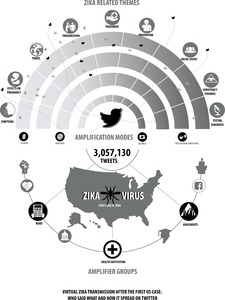Vijaykumar, Santosh, Nowak, Glen, Himelboim, Itai and Jin, Yan (2018) Virtual Zika Transmission after the first US Case: Who said What and How It Spread on Twitter. American Journal of Infection Control, 46 (5). pp. 549-557. ISSN 0196-6553
|
Text
AJIC Revised Final for Submission.docx - Accepted Version Download (1MB) |
||
![[img]](/32444/2.hassmallThumbnailVersion/Graphical%20Abstract.png)
|
Image (Graphical Abstract)
Graphical Abstract.png - Cover Image Download (841kB) | Preview |
|
|
Text (Article)
AJIC Revised Final for Submission.pdf - Accepted Version Download (1MB) | Preview |
Abstract
Background: This paper goes beyond detecting specific themes within Zika-related chatter on Twitter, to identify the key actors who influence the diffusive process through which some themes are more
amplified than others are.
Methods: We collected all Zika-related tweets during the three months immediately after the first U.S. case of Zika. Following categorization into twelve themes, a cross-section of tweets were grouped into weekly datasets to capture 12 amplifier/user groups and analysed by four
amplification modes: mentions, retweets, talkers, and twitter-wide amplifiers.
Results: We analysed 3,057,130 tweets in the US and categorized 4,997 users. The most talked about theme was Zika transmission (~58%). News media, public health institutions and grassroots users were the most
visible and frequent sources and disseminators of Zika-related Twitter content. Grassroots users were the primary source and disseminators of conspiracy theories.
Discussion & Conclusions: Social media analytics enable public health institutions to quickly learn what information is being disseminated, and by whom, regarding infectious diseases. Such information can help public
health institutions identify and engage with news media and other active information providers. It also provides insights into media and public concerns, accuracy of information on Twitter, and information gaps that
may exist. The study identifies implications for pandemic preparedness and response in the digital era and presents the agenda for future research and practice.
| Item Type: | Article |
|---|---|
| Subjects: | B900 Others in Subjects allied to Medicine P300 Media studies |
| Department: | Faculties > Health and Life Sciences > Psychology |
| Depositing User: | Santosh Vijaykumar |
| Date Deposited: | 07 Feb 2018 11:43 |
| Last Modified: | 01 Aug 2021 07:49 |
| URI: | http://nrl.northumbria.ac.uk/id/eprint/32444 |
Downloads
Downloads per month over past year







